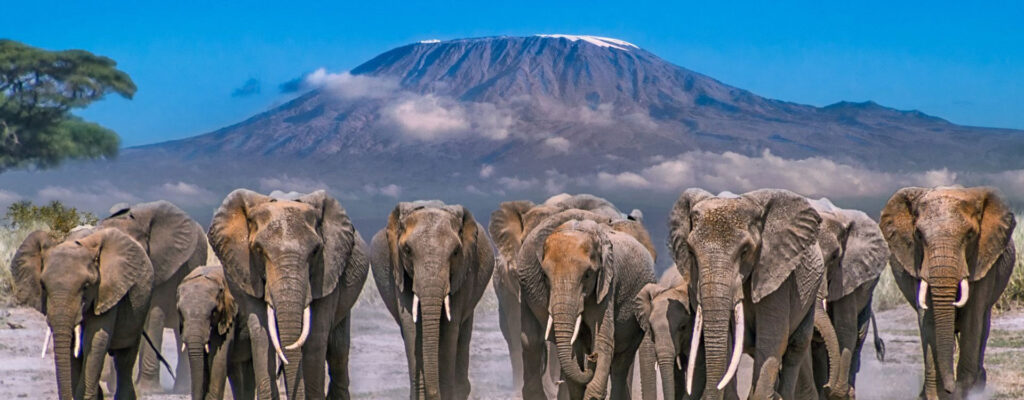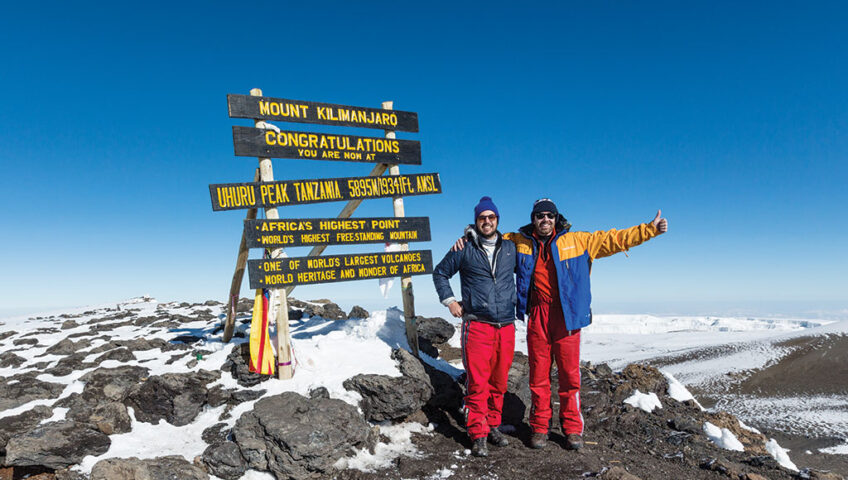Tanzania is home to Mountain Kilimanjaro National Park. situated in Tanzania’s Kilimanjaro area, 190 kilometers towards the southern hemisphere. It has a boundary with the city of Moshi and is 1,688 square kilometers in size. Mountain Kilimanjaro, one of Africa’s seven natural wonders, is situated close to Kenya’s northern border and has been designated a UNESCO World Heritage site. The tallest peak in Africa is included in the national park. With its highest point at 5895 meters, Mount Kilimanjaro, also referred to as “the mountain of light,” is the highest point in all of Africa. The park is divided into five unique zones, one of which is the arctic zone, where there is a lot of snow over 5000 meters.
In 1973, it was gazetted as a national park. The German colonial rulers classified Mountain Kilimanjaro and the surrounding forest as a game reserve during the colonial era, when Tanzania was still known as Tanganyika. Up until 1973, when the Tanzania Parks Authority (TANAPA) designated it as a national park.
ANIMALS IN THE PARK
Mountain Kilimanjaro National Park is the ideal location for a traveler interested in wildlife safaris because it is home to a variety of unique wildlife creatures. The African big five can be found in the park.
ELEPHANTS
The elephant, or Loxodonta Africana as it is scientifically termed, can weigh between 6000 and 7000 kg and stand about 3 meters tall when fully grown. While female elephants are typically found in groups headed by a matriarch and surrounded by younger females and their children, male elephants prefer to live alone. The herds, which are headed by matriarchs, can have up to 110 individual female elephants, including moms, daughters, sisters, and aunts. Elephants live in the sub-Saharan flora and savannah grasslands. Elephants use extremely low frequencies that are inaudible to human ears to communicate over great distances. The mother elephant surrounds its offspring to protect them when they are in danger. Elephants can outpace humans despite their enormous size, and they are typically peaceful and kind until they are startled.
LEOPARDS
The leopard, often known as the “Panther Pardus,” is the best climber among the Big Five. The nocturnal carnivores emerge from hiding in the evening and night to search for prey, which they consume from the treetops to avoid attention from the lions and hyenas, as they spend the better part of their day hidden and finding it very difficult to do so during the day. Leopards frequently linger for a long time in one location. Because of the color of their skin, they can comfortably relax in the woods and caverns, which are their natural homes. They can readily catch prey thanks to their fast running speed of about 56 kph, their strength to jump over 3 meters in the air, and the fact that they are members of the cat family, which gives them keen eyesight. The leopards are excellent swimmers as well.
BLACK RHINOCEROS
The rhino is the second-largest mammal in terms of size, right behind elephants. As herbivores, rhinos live in meadows and travel in packs known as crashes. Their gestation period ranges from two to five years, and females usually give birth to single calves or occasionally twins. The bone calf is fed by its mother for roughly three years during its 18-month gestation period. Rhinos’ poor vision causes them to frequently knock things over. Rhinos have excellent hearing and smell senses despite having poor eyesight. When the female detects that the calf has been attacked, she can flee at a pace of 56 kph, weighing between 1800 and 2500 kg.
CAPE BUFFALOS
These animals are extremely deadly, always wandering alone. They are extremely hazardous because when they sense danger, they charge at breakneck speeds. The bulls stand when they are approached and then charge. The rainy season is when the buffaloes breed and give birth; the gestation period is 11.5 months. During its first five weeks, the baby is always hidden and cared for by its mother.
AFRICAN LION
The panther is known botanically. The most vicious animal in the jungle is the lion, Leo. These cats, who live in groups of up to 15, are gregarious creatures. Because to their strength, they are frequently referred to as the “king of the jungle.” Lions are significant in culture because they stand for power, bravery, and monarchy. While lions are gregarious creatures, they only prey on other animals when they need to survive. The thick mane and physical stature of the male lion help to differentiate it from the female, which appears to be smaller physically. Male lions weigh about 120 kg.
Giraffes, servals, hyenas, baboons, monkeys, antelopes, aardvarks, mongooses, honey badgers, tree hyraxes, and bush babies are among the numerous creatures in the park. Any traveler visiting the second-largest continent in the globe shouldn’t skip seeing some of the abundant wildlife that can be found there. The animals are divided into nocturnal and diurnal species. The majority of the animals eat and play throughout the day, making sunny afternoons the greatest time to watch them when they are forced to roam the park by the heat. The greatest time to see nocturnals is in the very early morning because they hurt during the night and have adaptations for that, making it dangerous for late-night game drives safaris.
BIRDS IN THE PARK
Because there are so many different flying species in East Africa, this area is known as a bird sanctuary. This is also true of Mountain Kilimanjaro National Park, which is home to several bird species that fill the air with music.
You can spot some of these common bird species when visiting the park.
TURACOS
These three species—Hartlaub’s Turaco, Schalow’s Turaco, and Violet Crested Turaco—are among those you might see at Kilimanjaro National Park. These sociable birds gather in groups of dozens and are frequently seen doing so. They mostly eat fruit and plant stuff for food. Gustav Hartlaub, a doctor from Germany, is the name of the Hartlaub. Hermann Schalow, a German financier, inspired the name Schalow.
AFRICAN PITTA
The “holy grail” of species, it is challenging to observe. It’s rare to catch a glimpse of it, despite its bursting bright colors. Their flanks, breast, and neck are mustard yellow, and their throat is a light salmon pink.Their dark green wings have accents of black, turquoise, and royal blue, while their underbelly and tail are scarlet.
CINNAMON CHESTED BEE EATER
species is found near the edges of forests, on wooded hillsides, in clearings, and in gardens. Because it eats other flying creatures like honeybees, moths, butterflies, dragonflies, and beetles, it is sort of a predator.
NARINA TROGON
named for Frenchman Francois Le Vaillant’s mistress. The word for flower in Khoi Khoi is Narnia. The coloring of the sexes differs, with the soft brown and dull red of the females being less dramatic than that of the males.Males make a low, repetitive hoot when seeking to court females or protect their territory.
HORNBILLS
Additionally, you’ll be able to catch a glimpse of these unique bird species. The omnivorous hornbill consumes fruits, insects, small birds, rodents, tiny reptiles, centipedes, and centipede eggs.Although they frequently roost in couples, they have also been observed in large flocks of hundreds of birds.
KINGFISHERS
such as the African pygmy Kingfisher and the Malachite Kingfisher. These beautiful blue or green birds are mesmerizing. These covert, quiet birds build their nests either into a ground termite nest or tunnels made by both sexes in sandy soil banks.Both parents provide for the children.
Numerous varieties of cuckoos, chats, barbets, woodpeckers, starlings, sunbirds, shrikes, and flycatchers are among the other bird species found in the park.
Mountain Kilimanjaro is the park’s other main draw. The mountain was home to the well-known volcanic cones “Mawenzi,” “Kibo,” and “Shira.” The highest mountain in Africa, Mount Kilimanjaro, also happens to have the highest freestanding peak in the world at one of its summits. The Uhuru peak of the mountain is 5,895 meters high. The mountain Mount Kilimanjaro is also the most hiked. with a variety of unique ascent routes. This magnificent mountain’s presence gives the park extra flair.
ACTIVITIES
TREKKING AND HIKING MOUNTAIN KILIMANJARO
One of the primary activities at the Mountain Kilimanjaro National Park is this. This mountain may be hiked in a very daring fashion because hikers can witness a lot of wildlife along the way. Depending on your itinerary, climbing Mount Kilimanjaro can take you anywhere from 5 to 9 days. There are more than five ways to reach the top. Because this activity requires camping, it is typically done in groups. The mountain top is primarily covered in snow, and as the phrase goes, “the higher you go, the cooler it becomes.” Because of this and the fact that the temperature drops as you ascend, it is suggested to bring cardigans.
WILDLIFE SAFARIS
The park is blessed with all five of the big African mammals as well as many smaller unique animal species. Through the regularly planned game drive safaris, visitors can see some of the park’s animals, some of which were already described. Through these wildlife safaris, visitors led by rangers and guides get a peek of the park’s creatures. The Shira Plateau and Chala Crater Lake are two noteworthy natural attractions that can be seen by tourists.

COMMUNITY WALKS AND NATURE WALKS
Because they bring you closer to the park’s animals, the nature walks are led by heavily armed professionals. Because the tourists experience nature up close, it is quite daring.
On the other hand, community walks are a great way to become more familiar with the area around Kilimanjaro National Park, especially the fascinating masai people. Any traveler should visit these because of their extremely intriguing way of life and social structure.
The Park is reachable by both land and air. The experience would be more exciting on the road. It takes about two hours to drive through Moshi Town from Arusha to the Kilimanjaro National Park. It is a 50-minute journey from Moshi. It is accessible to tourists throughout the year, though it is advised to go during the dry season, which lasts from June to October.
ACCOMODATION
In and around Mountain Kilimanjaro National Park, there are several excellent lodging options. The choices range in price from cheap to luxurious, depending totally on the traveler’s budget. The venues include Kaliwa lodge, Shu’mata camp, Kambi Ya Tembo camp, Fortune Mountain Resort, Ndarakwai camp, Snowcap Cottages, Kilimanjaro Mountain Resort, Babylon lodge, Aishi Machame hotel, Mount Kilimanjaro View lodge, Kibo Slopes Cottages, Kilimanjaro Halisi Retreat, Salinero Millie lodge, Kilinopark hotel, Kilemakyaro Mountain lodge, Kilimanjaro White House hotel among others.


